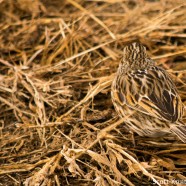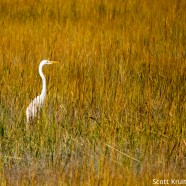Black-crowned Night-Heron
Here we have a foraging Black-crowned Night-Heron (Nycticorax nycticorax), a long-legged wader of marshes, ponds, and wetlands, enjoying fresh, salt or brackish waters. They are actually the most widespread heron in the world! Have they spread to your neighborhood? It is yet another of the many species we work to help through our efforts in the Audubon Alliance for Coastal Waterbirds. Scott Kruitbosch Conservation & Outreach Coordinator
Read MoreBirds Blending In
Here we have the backs of two different bird species – can you identify them? I have posted them both recently as opportunistic winter birds, and this Horned Lark in a roadway and Savannah Sparrow in grasses have another thing in common here with wonderful camouflage working in two very different situations. It cracked me up how well the Lark blended in to the snow, dirt, salt and sand in the road, even in the bright sunlight. While that is not evolution it certainly worked out well. Scott Kruitbosch Conservation & Outreach Coordinator
Read MoreOverwintering Great Egrets
Would you believe that I took this photo of a Great Egret (Ardea alba) in Connecticut only last week? It is exceptionally true and resident birders in New England can attest to the fact that we now have them as an overwintering species! Climate change is starting to allow us to keep more long-legged waders and shorebirds, such as the American Oystercatcher, year-round in parts of Long Island Sound and the New England Atlantic coastline. Why bother leaving when you can make it through the entire season? Migration is the most perilous part of the life of a bird and while a colder than usual or...
Read More






